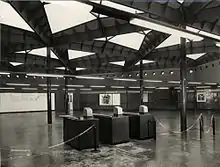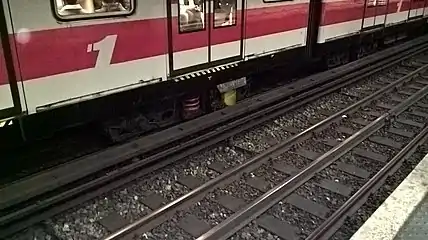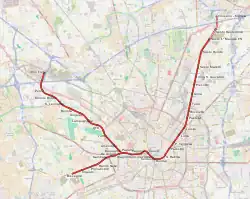Milan Metro Line 1
Line 1 (Linea Uno in Italian) is the first underground rapid transit line built in Milan, Italy. It is part of the Milan Metro and it is operated by ATM. Works on the line began in 1957, and the first part was opened on 1 November 1964,[4][5] running from Sesto Marelli to Lotto station. The line is also called Red Line (Linea Rossa in Italian), as it is visually identified by red signs. Due to its premiership, the line gave its red color to the Milan Metro logo.
| M1 | |||
|---|---|---|---|
 | |||
 Rho Fiera station entrance | |||
| Overview | |||
| Status | operational | ||
| Locale | Milan, Italy | ||
| Termini | |||
| Connecting lines | |||
| Stations | 38[1] | ||
| Service | |||
| Type | Rapid transit | ||
| System | Milan Metro | ||
| Operator(s) | Azienda Trasporti Milanesi | ||
| Depot(s) | Gallaratese, Precotto | ||
| Rolling stock | 63 trains:[2] UdT (various series) AnsaldoBreda Meneghino AnsaldoBreda Leonardo | ||
| Daily ridership | 500,000[3] | ||
| History | |||
| Opened | 1 November 1964 | ||
| Technical | |||
| Line length | 27 km (17 mi)[1] | ||
| Track gauge | 1,435 mm (4 ft 8+1⁄2 in) standard gauge | ||
| Electrification | 750 V DC fourth rail or overhead catenary (overground depots only) | ||
| |||
Route
The line runs underground from the northern suburb of Sesto San Giovanni to the city centre, then to the western district with two different branches, one northwest to Rho, the other to the west to Bisceglie. It is 27 km (17 mi) long and serves 38 underground stations.[6]
Key points served by the line are Duomo, considered the center of Milan; Castello Sforzesco (with Cairoli station); Cadorna, one of the busiest stations in Milan and in Italy; Corso Buenos Aires (with stations Porta Venezia, Lima and Loreto), an important shopping street; and Rho Fiera, one of the largest fairgrounds in the world.[7]
| Station Name | Transfer | Branch | Opening |
|---|---|---|---|
| Sesto I Maggio | Main route | 28 September 1986 | |
| Sesto Rondò | |||
| Sesto Marelli | 1 November 1964 | ||
| Villa San Giovanni | |||
| Precotto | |||
| Gorla | |||
| Turro | |||
| Rovereto | |||
| Pasteur | |||
| Loreto | |||
| Lima | |||
| Porta Venezia | |||
| Palestro | |||
| San Babila | |||
| Duomo | |||
| Cordusio | |||
| Cairoli | |||
| Cadorna |
| ||
| Conciliazione | |||
| Pagano | |||
| Buonarroti | Rho Fieramilano branch | 1 November 1964 | |
| Amendola | |||
| Lotto | |||
| QT8 | 8 November 1975 | ||
| Lampugnano | 12 April 1980 | ||
| Uruguay | |||
| Bonola | |||
| San Leonardo | |||
| Molino Dorino | 28 September 1986 | ||
| Pero | 19 December 2005 | ||
| Rho Fieramilano | |||
| Wagner | Bisceglie branch | 2 April 1966 | |
| De Angeli | |||
| Gambara | |||
| Bande Nere | 18 April 1975 | ||
| Primaticcio | |||
| Inganni | |||
| Bisceglie | 21 March 1992 |
History


On 6 April 1952 the city administration asked for a project of a metro system and on 6 October 1955 a new company, Metropolitana Milanese, was created to manage the construction of the new infrastructure.[8] The project was funded with ₤ 500 million from the municipality and the rest from a loan. The construction site of the first line was opened in viale Monte Rosa on 4 May 1957.[8] Stations on the new line were designed by Franco Albini-Franca Helg architecture studio. Bob Noorda designed the famous wayfinding and signage system.[8]
At first, stations were designed without the mezzanine floor. However, these were added to the final design to allow street crossing and the use of gates to collect tickets.
The line from Lotto to Sesto Marelli (21 stations) opened on 1 November 1964, after seven years of construction works.[9]
Rolling stock
There are 4 types of trains running on the line: the original first series trains, revamped original trains, AnsaldoBreda Meneghino trains and the new Leonardo train introduced in 2015. The track gauge is the 1,435 mm (4 ft 8+1⁄2 in) standard gauge. The entire line is electrified by means of a third or fourth rail at 750 V DC.[10]
Among the 63 trains running on the line, 20 entered service between 1964 (opening of the line) and 1970. Those trains are planned to be replaced by new Meneghino trains in the next few years. There are 17 Meneghino trains already operational as of March 2012.[2]
Extension
An extension towards the north from Sesto Primo Maggio to Cinisello/Bettola is currently under construction. It is expected to be completed by 2023.[11] The new section will be 1.9 km (1.2 mi) long with 2 stations (Sesto Restellone and Cinisello/Bettola), entirely underground. The total cost will be €206 million.[12]
| Station Name | Transfer | Grade |
|---|---|---|
| Sesto Restellone | Underground | |
| Cinisello/Bettola | Underground |
An extension of the western branch from Bisceglie towards the city limits has been approved. The new stations will be located at Baggio, via Valsesia and at Quartiere Olmi. The national government will provide €210 million, while the total cost is estimated at €350 million.[13]
| Station Name | Transfer | Grade |
|---|---|---|
| Valesia | Underground | |
| Baggio | Underground | |
| Quartiere Olmi | Underground |
Gallery
 A M1 tunnel showing the electrical feeding system
A M1 tunnel showing the electrical feeding system Inside a fully revamped train
Inside a fully revamped train A train on Milan Metro's Line 1 showing the fourth-rail contact shoe.
A train on Milan Metro's Line 1 showing the fourth-rail contact shoe.
Notes
- "Metropolitana Milanese - Milano M1". Archived from the original on 2013-10-19. Retrieved 2013-07-20.
- "Metrò rossa a rischio paralisi da cambiare un terzo dei treni". la Repubblica. 8 March 2012. Archived from the original on 11 March 2012. Retrieved 9 March 2012.
- "1964-2014, Milano festeggia 50 anni della linea 1 del metrò: "Così siamo diventati europei"". la Repubblica. 1 November 2014. Retrieved 4 November 2014.
- "ATM - Storia". Azienda Trasporti Milanesi. Retrieved 5 October 2011.
- "Carta della mobilità 2011" (PDF). Azienda Trasporti Milanesi. Archived from the original (PDF) on 29 March 2012. Retrieved 5 October 2011.
- "Linea M1 di Milano: il nuovo segnalamento entra in attività durante il ponte del 1°novembre". I binari - CityRailways. 31 October 2011. Archived from the original on 3 April 2012. Retrieved 3 November 2011.
- "About us". FieraMilano. Archived from the original on 22 July 2011. Retrieved 19 October 2011.
- "La storia della linea 1". Metropolitana Milanese Spa. Archived from the original on 5 March 2016. Retrieved 31 October 2011.
- Milan Opens Its First Metro International Railway Journal February 1965 page 22
- "Milan Metro". metrobits.org. Retrieved 5 October 2011.
- Quattrone, Ilaria (15 January 2021). "Metro M1 fino a Monza, si sblocca il cantiere: ripartono i lavori a Sesto San Giovanni" (in Italian). FanPage.it. Retrieved 6 April 2021.
- Stella, Armando (14 March 2011). "Metrò per Monza, ad aprile primi cantieri". Corriere della Sera. Archived from the original on 21 June 2011. Retrieved 5 October 2011.
- Dazzi, Zita (5 November 2019). "Arrivano i fondi per il prolungamento della M1 a Baggio: il governo stanzia 210 milioni". Repubblica. Retrieved 19 December 2019.

.svg.png.webp)